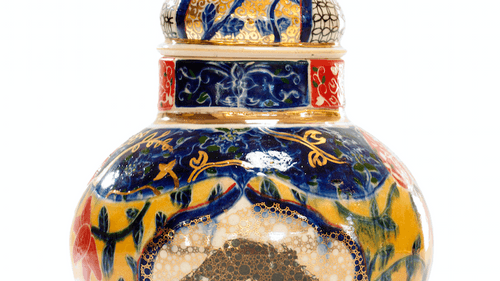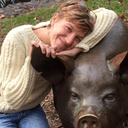Stay in the Loop
BSR publishes on a weekly schedule, with an email newsletter every Wednesday and Thursday morning. There’s no paywall, and subscribing is always free.
Placing us in corpus
Woodmere Art Museum Annual: 77th Juried Exhibition

The Woodmere Annual: 77th Juried Exhibition opened earlier this month at the Woodmere Art Museum, showcasing 100 pieces of art from 75 selected artists. Requirements for submission? All artists had to be from within a 50-mile radius of the museum, and entries were asked to engage with the ideas of land, body, and movement through the world.
The theme was chosen by juror Syd Carpenter, a professor of studio art at Swarthmore College and a sculptor in her own right. Given her rarefied credentials (she specializes in ceramics and has had work displayed at the Philadelphia Museum of Art and the Smithsonian’s Renwick Gallery, among others), one might expect a highbrow collection characterized by intellectual abstraction.
Instead, the exhibition is a pointed alternative to more chaotic and intellectualized contemporary art displays. With thought and consideration, the exhibition demands the viewer’s uncompromising engagement with the diverse bodies of self, artist, and work.
Built by association
At first it might not be apparent what exactly a clay mug has to do with land, body, or movement, let alone how it challenges a norm. “A mug? So what?” you might say. “I use those every day.”
But Carpenter, with her sculptor’s eye, has an intimate understanding of how the viewer interacts with art and is quick to use physical position to draw out the relevance of each work. The mugs of Rowdy Vessels (2017) compel the viewer to move, to engage their body in exploring the mugs’ form.
Through such exploration, the viewer is called to linger and loop from one piece to the next, creating a network of associations between each piece in the gallery. In return, they are rewarded for their efforts.

When the mugs are viewed in relation to the strict geometry of monochromatic ceramics such as Orange Chromatic Ewer (2015), the sinuous curve becomes a formal challenge to the strict line, a delightful discovery that turns each step into a treasure hunt for even more artistic meaning.
As Carpenter explained, “One way I evaluate the quality of a sculpture is, does it make you want to move? To see it from one perspective and then immediately want to walk around to another angle?”
The Woodmere’s open floor plan shows off Carpenter’s organizational theory to grand effect. With installations placed almost sporadically throughout the room, they’re blissfully freed from display cases and docents demanding that you step back.
"Screaming and kicking to the truth"
In fact, the art demands that you step closer. In Market/Frankford El (2016), painter Leroy Johnson layers strati of paint and print in a thickly glistening view from the Market/Frankford line. The painting’s surface captures arcs of light streaking across the paintbrush ridges, evoking a sense of the motions and movements that compose a large part of so many Philadelphians’ physical experience.
The exhibition’s consideration of the body takes just as many forms as the human body itself. One of the exhibition’s cornerstones is Barbara Bullock’s Trayvon Martin, Most Precious Blood (2013–2014). Suspended opposite the gallery’s entry, the architectural cutout speaks both literally of its namesake and figuratively to the national body.

As Carpenter explained in an interview, “We need to understand that Trayvon Martin represents a shudder, a bodily shudder, that our country needs to acknowledge, and [Bullock] has represented it brilliantly… She suggests a torso, but then there’s this explosive quality coming from the piece. It represents being pulled screaming and kicking to the truth. It’s important that artists use this opportunity right now.”
This awareness of contemporary political and social imperatives is, perhaps, the true driver of the 2018 Annual. Trayvon Martin, Most Precious Blood, a small bronze bust of Mary McLeod Bethune, and Carpenter’s own Storage 1 are the exhibition’s specially featured works. All works by African-American female artists, they call into question ideas of identity in America and ground the conceptual focus of the exhibition in all-too-present national realities.
These realities, most recently, give dark new valence to other works, such as Tabitha Arnold’s weaving Panopticon (2018), a wool and cotton war rug depicting the rigid arms of a prison slicing through the neighborhoods surrounding it.
Understanding beyond the Display Stand
There is so much meaning and intention behind each piece in Woodmere’s Annual: 77th — not to mention behind the exhibition as a whole — that the museum has dedicated an episode of its podcast to interviews with Carpenter and several other artists featured in the exhibition. An online catalog also includes a transcription of a conversation with Carpenter about the selection process, as well as notes from the gallery director.
What, When, Where
Woodmere Annual: 77th Juried Exhibition. Through September 3, 2018, at the Woodmere Art Museum, 9201 Germantown Avenue, Philadelphia. (215) 247-0476 or woodmereartmuseum.org.
Sign up for our newsletter
All of the week's new articles, all in one place. Sign up for the free weekly BSR newsletters, and don't miss a conversation.

 Helen Walsh
Helen Walsh